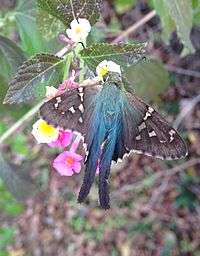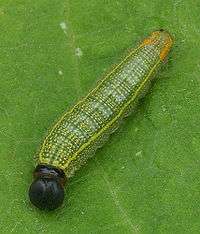Long-tailed skipper
| Long-tailed skipper | |
|---|---|
| | |
| Scientific classification | |
| Kingdom: | Animalia |
| Phylum: | Arthropoda |
| Class: | Insecta |
| Order: | Lepidoptera |
| Family: | Hesperiidae |
| Genus: | Urbanus |
| Species: | U. proteus |
| Binomial name | |
| Urbanus proteus (Linnaeus, 1758) | |
The long-tailed skipper (Urbanus proteus) is a spread-winged skipper butterfly found throughout tropical and subtropical South America, south to Argentina and north into the southern part of the United States of America. It cannot live in areas with prolonged frost. It is a showy butterfly, with wings of light brown tinted with iridescent blue, and two long tails extending from the hindwings. The robust body is light blue dorsally. It has a large head, prominent eyes, and a wingspan between 4.5 and 6 centimeters.



Life cycle
It lays white or yellow eggs, singly or in small clusters, which hatch into a caterpillar with a yellowish body and large, dark head. After two to three weeks, the caterpillar forms a pupa. Its pupa is contained in a rolled leaf and covered in fine bluish hairs. The pupa stage may last from one to three weeks, after which the adult emerges.
The caterpillar of this skipper is a common pest of crops, especially beans, in the southern United States. For this reason, it is sometimes called the bean leafroller in that area. The caterpillars are also known to attack ornamental plants in the legume family such as wisteria and butterfly peas. The caterpillars feed on leaves and then roll the leaves around themselves, lining the cavity with silk, to pupate. The adults feed on nectar from flowers.
References
- Butterflies and Moths of North America Fact Page
- U. proteus on the UF/IFAS Featured Creatures Web site
- Butterflies of Houston and Southeast Texas, by John & Gloria Tveten